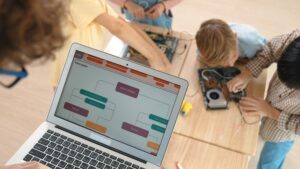Book a FREE Trial
See why Code Galaxy is the #1 online coding
school of choice for students & parents.
Coding not only equips kids with valuable technical skills but also fosters creativity, problem-solving, and logical thinking. If you’re wondering how to learn coding for kids, this step-by-step guide will help you navigate the journey, ensuring a fun and engaging experience for your child.

Before diving into coding itself, it’s important to explain what coding is in simple terms. Coding is the process of giving instructions to a computer to perform specific tasks. These instructions are written in various programming languages, which are like the languages we speak, except they are designed for computers.
To help your child grasp this concept, you can use analogies like comparing coding to creating a recipe. Just as a recipe provides step-by-step instructions for cooking a dish, coding provides step-by-step instructions for making a computer do something, like creating a game or an app.
Kids learn best when they’re genuinely interested in a subject. To make coding appealing, connect it to something they already love. If your child is a fan of video games, explain how coding is used to create those games. If they enjoy music or art, show them how coding can be used to create digital art or compose music. Explore resources like The Code Galaxy to find courses that align with your child’s interests, whether it’s game development, animation, or interactive stories.
For beginners, especially younger kids, starting with a visual, block-based coding language like Scratch is ideal. Scratch, developed by MIT, allows kids to create interactive stories, games, and animations by dragging and dropping code blocks. This method helps them understand coding concepts without getting bogged down by complex syntax. The Code Galaxy offers a structured curriculum that introduces kids to Scratch and other beginner-friendly coding languages, ensuring they build a strong foundation.
Once your child is comfortable with the basics, encourage them to start creating their own projects. Hands-on learning is crucial for retaining new skills and building confidence. Let them experiment with different ideas, make mistakes, and learn from them.

As your child becomes more proficient, it’s time to introduce them to more advanced programming languages. Depending on their interests, you can start with Python, JavaScript, or even Java. These languages are more text-based and will introduce your child to more complex coding concepts.
Python is particularly popular because of its simplicity and versatility, making it an excellent next step after Scratch. JavaScript is great for kids interested in web development, while Java is often used in game development.
See why Code Galaxy is the #1 online coding
school of choice for students & parents.
While self-learning is valuable, having a mentor or enrolling in a coding class can significantly enhance your child’s learning experience. A mentor can provide personalized guidance, answer questions, and help your child overcome challenges.
Consider enrolling your child in specialized coding classes like those offered by The Code Galaxy. These classes are designed specifically for kids, with age-appropriate content and a focus on making learning fun and engaging.
There are numerous coding games and apps designed to make learning to code fun and interactive. These tools often incorporate game-like elements that motivate kids to keep learning. Some popular coding games and platforms include:
For a comprehensive list of coding resources, check out The Code Galaxy’s blog, where you’ll find recommendations tailored to different age groups and skill levels.

Finally, remember that learning coding should be a fun and rewarding experience for your child. Encourage them to explore their interests, whether that’s creating a game, building a website, or programming a robot. Celebrate their successes, no matter how small, and remind them that making mistakes is a natural part of the learning process.
Learning to code is a journey that can open up countless opportunities for your child. By following this step-by-step guide, you can ensure that your child develops a strong foundation in coding while enjoying the process. Whether they’re just starting out with Scratch or moving on to more advanced programming languages, resources like The Code Galaxy are there to support them every step of the way.
Encourage your child to dive into the world of coding, and watch as they develop not only valuable technical skills but also a love for learning and creating.
See why Code Galaxy is the #1 online coding
school of choice for students & parents.